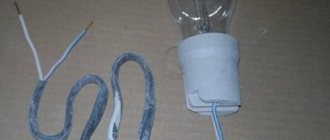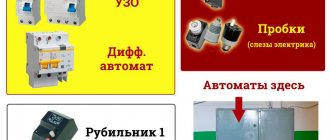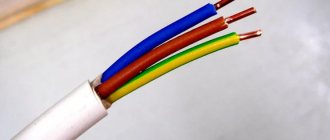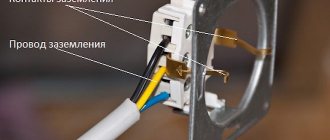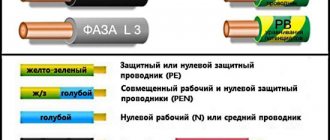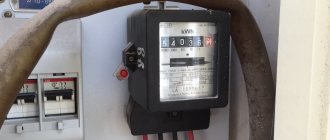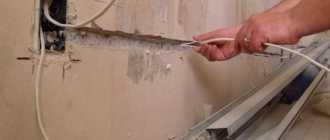Two phases in one socket
The most common reason for the presence of alternating electric current in both sockets is a break in the neutral wire. In this case, the flow of current stops, but the phase wire, both terminals of the lamp and the section of the wire are at “zero” under voltage. A break can occur anywhere:
- in a junction box;
- on the chandelier;
- in the wall;
- in the electrical room.
Fixing this problem is quite simple; you just need to clean and securely fasten the neutral wire in the place where it is damaged. To do this, you need to perform the following algorithm of actions:
- Check the functionality of the socket.
- Cut off power to the entire apartment.
- Check the socket with an indicator.
- Examine the quality of connections in the junction box.
- If everything is in order, pay attention to the electrical panel.
- Fix the detected problem.
But if there is a break in the neutral wire in the electrical wiring hidden deep in the wall, difficulties may arise in identifying and eliminating the fault.
Two phases in several sockets
If a wire break to “zero” occurs in one of the distribution boxes at home, only part of the network will be lost. The rooms powered by this box will remain without electricity. If there is a break in the line, some of the sockets will fail, while others will continue to function normally. Often a separate group of sockets has 2 phases due to damage to the neutral conductor with its subsequent short circuit.
This problem is often a consequence of outdated plugs and electrical wiring. To restore the functionality of the sockets, you need to eliminate the wiring fault in this area.
Incorrect connection of the switch to the chandelier
In old apartments, a mistake was often made: it was not the phase that was broken, but the zero. In this situation, the lighting from the switch worked normally, but there was a danger of electrical injury when replacing the light bulb, which was always at phase potential.
If in such a situation you use a capacitive indicator, it will light up on both contacts of the light bulb base and one on the switch.
The reason lies in the fact that the phase potential along the broken chain from the apartment panel reached the disconnected contact of the switch.
But there are no conditions for the passage of current - the circuit is open. In their own language, electricians say - a gap or break in the zero.
A similar situation can occur in an electrical outlet. To do this, it is enough to disconnect the zero at the input of their block and have a parallel circuit with a connected resistance, for example, a table lamp.
A similar case may arise in a simplified home wiring diagram, when the separation of the power circuits of the socket group and lighting is not carried out, and all the protection of the apartment is provided by electrical plugs or circuit breakers of the PAR series.
If the zero is broken at the input of the socket, located, for example, in the kitchen and the light switch in the room is turned on, a similar situation will be repeated when the capacitive voltage indicator lights up in both sockets of the socket, indicating the phase potential.
Why are there two phases in the socket?
Only one phase enters the apartment through the meter and machines. The socket must have one phase and zero, and in the above situation, the indicator indicates the presence of the same phase in both sockets of the socket.
The most likely cause of the malfunction in this case is damage (break) of the neutral wire going to the socket during the process of drilling the wall.
The presence of a phase where zero should be is due to the fact that it passes through a load - a constantly on light bulb or some other electrical appliance.
As a rule, all neutral wires in a house or apartment are connected to the neutral bus of the electrical panel; a phase will appear in the socket. This is very easy to check - you just need to turn off all electrical appliances in the apartment.
How to determine using an indicator
You can detect the presence of voltage in the outlet using a special indicator screwdriver. After the lights in the room are turned off, you need to check any socket using an indicator. Bright blinking of the screwdriver in two sockets indicates the appearance of the second phase.
Next, you need to determine where the breakdown occurred: inside the apartment or on the external panel. To do this, you need to take any household device and connect it to the outlet closest to the panel. The device must be turned on. This is necessary so that the voltage flows through the device to the neutral conductor. All other equipment must be turned off!
How can two phases appear in a regular 220-volt outlet?
From school physics lessons, everyone has learned a little knowledge about electricity and knows how many phases there are in an outlet. In serviceable ones there is always one phase and zero. When carrying out repair work or operating the electrical supply system, the lighting of an apartment or a separate room sometimes disappears. What to do? If, after turning on the gas station, the apartment’s electrical appliances do not work. Measuring the presence of voltage indicates that the socket shows two phases; what reason could lead to this malfunction - this needs to be clarified.
Experience shows that a common cause of this phenomenon is a break in the neutral wire. The presence of a phase instead of zero is explained by the fact that the voltage, passing through any switched-on network element, returns to the zero contact of the electrical outlet.
In order to verify the correctness of this statement, it is enough to turn off all electrical equipment in the apartment.
The following may cause a malfunction:
- faulty fuses;
- break of the neutral electrical wire of the input distribution board;
- break of ground junction box of the room;
- breakdown of electrical plugs when using old wiring.
Two phases in half the rooms
This happens if the distribution boxes are connected in series one after the other. What to do in this case - the solution is standard - you need to sequentially go through all the boxes in search of bad contact.
The whole difficulty is that often there is no connection diagram, so it is not known from which room and into which of them the wiring is laid. You should also take into account the option that the contact can burn out both in a room in which the sockets do not work, and in the previous one according to the diagram, where the indicator shows normal voltage in the sockets.
There is a solution so as not to disassemble the terminal boxes in all rooms - you can change the phase and zero on the input panel, and then use a voltage indicator that can show the phase through the wall. Before doing this, you need to make sure that there is no grounding anywhere in the sockets and, just in case, disconnect the grounding, if one is connected.
How the electrical grid works and how electricity is supplied to the house
To understand the reason for the appearance of two phases in an outlet, you need to understand how the electrical network is structured and how electricity is supplied to the house. Initially, the line looks like three phases, which are distributed to each consumer so as not to load each phase so much.
If the load is uneven, phase imbalance occurs, and the consumer faces a number of problems, in particular those associated with low-quality electricity.
So, in order to redistribute the load on the substation, there are initially three phases. Already at the feeder, the phases are divided into one, as a result of which the consumer receives a single-phase voltage of 220 Volts.
In this case, all consumer houses are connected to one common zero, which leads to the problem that is discussed in this article in the construction magazine, namely, the appearance of two phases.
And if a zero break occurs, then several phases will be connected to each other through the load (from the consumer). As a result, there will be a linear voltage of 380 Volts between the phases.
Zero break in the entrance panel of a house or apartment.
In the input panel of a house or apartment, the neutral wire may break at the input circuit breaker or at the neutral bus. As a rule, the screw connection becomes loose, causing contact between the wire and the clamp to be lost, or, in rare cases, the neutral wire breaks off at the clamp and hangs in the air.
Also, due to poor contact between the clamp and the wire, the wire heats up and burns and, as a result, a large transition resistance in the form of soot forms
, which gradually turns into a cliff.
If there is no zero, all electrical appliances in the house will not work. But if at least one household appliance remains plugged in or the light switch remains on, the phase through the radio components of the power supply
household appliances or
filament
will pass unhindered to the zero bus, and from the bus to all neutral wires of the electrical wiring. And as a result, there will be a phase on both sockets of sockets and contacts of switches. This is because all the neutral wires of the electrical wiring are connected together at the neutral bus.
To determine such a malfunction, it is enough to unplug all household appliances from the sockets and turn off all light switches or unscrew the light bulbs. After these actions, the second phase from the sockets and switch contacts will disappear. The malfunction is treated by restoring the contacts on the terminals of the input circuit breaker or on the zero bus.
About the presence of a second phase in the socket
The phase indication on two contacts of a plug socket in most cases does not indicate the presence of two phases. To verify this, it is enough to measure the voltage between the contacts with a multimeter. Although the possibility of the appearance of interphase voltage cannot be completely excluded, this is a characteristic sign of a break in the main zero with subsequent phase displacement. We propose to consider all possible options, first we list them:
- Zero break at the input.
- Loss of electrical contact between one of the lines and the neutral bus in the distribution box.
- Zero break followed by short circuit to phase.
- Damage to the main neutral core with subsequent phase displacement.
It is typical that in the first three options, if you connect the device to a problematic outlet, it simply will not function. As for the latter case, when the phases are shifted, there is a high probability of failure of all electrical devices connected to the network. What this is connected with will be discussed further.
Break of zero at the input
One of the characteristic malfunctions of old electrical wiring is the burnout of the zero on the zero bus (see A in Fig. 3) or the loss of electrical contact on the input circuit breaker (B). In most cases, the reason lies in the use of aluminum wires, the plasticity of which causes the contact connections to weaken. Violation of the quality of the electrical contact leads to an increase in its transition resistance, resulting in wire burnout. Note that problems can also arise with copper cables if the wire connections are not securely connected.
Figure 3. Typical problem areas: zero bus (A) and input circuit breaker (B)
If the neutral wire on the input circuit breaker in the apartment is damaged, not one of the household consumers will work. But at the same time, if at least one electrical appliance is connected to the network, a phase potential will be established on all neutral conductors (see A in Fig. 4).
